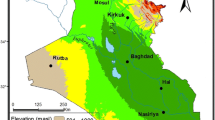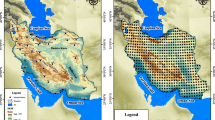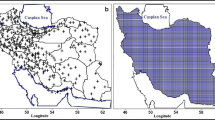Abstract
In this study, long-term annual and monthly trends in mean maximum, mean minimum and mean temperature are investigated at 35 synoptic stations in Iran. The statistical significance of trends is assessed by the Mann–Kendall test. Most stations, especially those in western and eastern parts of country, had significant positive trends in monthly temperature time series in summer season. However, the maximum number of stations with the positive trend were observed in April (30 stations), and then in August (29 stations) while the negative trends were seen in February (16 stations) and March (15 stations). On annual scale, most stations in western and southern parts of Iran had significant positive trend. Overall, about 71%, 66% and about 40% of stations had statistically significant trends in mean annual temperature, mean annual minimum temperature and in mean annual maximum temperature, respectively. These results, however, indicate that the climate in Iran is growing warmer, especially in summer.





Similar content being viewed by others
References
Aerts JCJH, Droogers P (2004) Climate change in contrasting river basins: adaptation strategies for water, food, and environment. Biddles Ltd, King’s Lynn, UK, p 306
Alexandersson H (1986) A homogeneity test applied to precipitation data. J Climatol 6:661–675
Amiri MJ, Eslamian SS (2010) Investigation of climate change in Iran. J Environ Sci Technol 3(4):208–216
Arndt, D.S., M.O. Baringer, and M.R. Johnson, Eds.: 2010, State of the climate in 2009. Bull. Am Meteorol Soc 91(6), S1–S224
Arnfield AJ (2003) Two decades of urban climate research: a review of turbulence, exchanges of energy and water, and the urban heat island. Int J Climatol 23:1–26. doi:10.1002/joc.859
Beaulieu C, Ouarda T, Seidou O (2007) A review of homogenization techniques for climate data and their applicability to precipitation series. Hydrol Sci J 52:18–37
Brunetti M, Buffoni L, Nanni T (2000) Trends of minimum and maximum daily temperature in Italy from 1865–1996. Theor Appl Climatol 66:49–60
Chaouche K, Neppel L, Dieulin C, Pujol N, Ladoucle B, Martin E, Salas D, Caballero Y (2010) Analyses of precipitation, temperature and evapotranspiration in a French Mediterranean region in the context of climate change. CR Geosci 342:234–243
Chung YS, Yoon MB (2000) Interpretation of recent temperature and precipitation trends observed in Korea. Theor Appl Climatol 67:171–180
Dinpashoh Y, Jhajharia D, Fakheri-Fard A, Singh VP, Kahya E (2011) Trends in reference crop vapotranspiration over Iran. J Hydrol 399:422–433
Domroes M, El-Tantawi A (2005) Recent temporal and spatial temperature changes in Egypt. Int J Climatol 25:51–63. doi:10.1002/joc.1114
Elagib NA, Mansell MG (2000) Climate impacts of environmental degradation in Sudan. Geol J 50:311–327. doi:10.1023/A:1011071917001
Evans JP (2010) Global warming impact on the dominant precipitation processes in the Middle East. Theor Appl Climatol 99:389–402
Ghasemi AR, Khalili D (2006) The influence of the Arctic Oscillation on winter temperatures in Iran. Theor Appl Climatol 85:149–164
Helsel DR, Hirsch RM (2002) Statistical methods in water resources. US Geol Surv pp 524
Hertig E, Seubert S, Jacobeit J (2010) Temperature extremes in the Mediterranean area: trends in the past and assessments for the future. Nat Hazards Earth Syst Sci 10:2039–2050. doi:10.5194/nhess-10-2039-2010
Hirsch RM, Slack JR, Smith RA (1982) Techniques of trend analysis for monthly water quality data. Water Resour Res 1:107–121
IPCC (2007) Climate change 2007: synthesis report. Valencia, Spain
Khalili A (1991) Comprehensive water resources project of Iran. Technical report of meteorology and climatology. Jamab Consulting Engineers Co., Vol 1, 892
Jiangping Z, Zhong Y, Daojie W, Xinbao Z (2002) Climate change and causes in the Yuanmou dry-hot valley of Yunnan, China. J Arid Environ 51:153–162
Kruger AC, Shongwe S (2004) Temperature trends in South Africa: 1960–2003. Int J Climatol 24:1929–1945
Lazaro R, Rodrigo FS, Gutierrez L, Domingo F, Puigdefabregas J (2001) Analysis of a 30-year rainfall record (1967-1997) in semi-arid SE Spain for implications on vegetation. J Arid Environ 48:373–395
Masoodian SA (2004) Temperature trends in Iran during the last half century. Geographical Research Quarterly 54:29–45
Maugeri M, Nanni T (1998) Surface air temperature variation in Italy: recent trends and an update to 1993. Theor Appl Climatol 61:191–196
Moberg A, Alexandersson H (1997a) Homogenization of Sweden temperature: Part I. Homogeneity test for linear trends. Int J Climatol 17:25–34
Moberg A, Alexandersson H (1997b) Homogenization of Swedish temperature data: Part II. Homogenized gridded air temperature compared with a subset of global gridded air temperature since 1861. Int J Climatol 17:35–54
Modarres R, Silva V (2007) Rainfall trends in arid & semi–arid regions of Iran. J Environ 70:344–355. doi:10.1016/j.jaridenv.024
Peterson TC, Easterling DA, Karl TR, Groisman P, Nicholls N, Plummer N, Torok S, Auer I, Boehm R, Gullett D, Vincent L, Heino R, Tuomenvirta H, Mestere O, Szentimrey T, Salinger J, Forland EJ, Hanssen-Bauer I, Alexandersson H, Jones P, Parker D (1998) Homogeneity adjustment of in situ atmospheric climate data: a review. Int J Climatol 18:1493–1517
Rahimzadeh F, Fatahi A, Hosseni DF (2005) Evaluation of variability of Climate with applying statistical methods in Iran. Water Resour Res 2(1):61–73
Raziei T, Arasteh PD, Saghafian B (2005) Annual rainfall trend in arid & semi–arid regions of Iran. ICID21st European regional Conference, pp 20–28
Saboohi R, Soltani S (2009) Trend Analysis of climatic factors in great cities of Iran. J Sci Technol Agric Nat Resour 46:303–322
Salas JD (1993) Analysis and modeling of hydrologic time series. In: Maidment DR (ed) Handbook of hydrology. McGraw-Hill, New York
Santer BD, Taylor KE, Wigley TM (1996) A search for human influences on the thermal structure of the atmosphere. Nature 382:39–46
Shirgholami H, Ghahreman B (2005) Trend analysis of mean annual temperature in Iran. Agric Nat Resour 1:9–23
Soltani S, Saboohi R, Yghmaei L (2011) Rainfall and rainy days trend in Iran. Clim Chang. doi:10.1007/s10584-011-0146-1
Syrakova M, Stefanova M (2009) Homogenization of Bulgarian temperature series. Int J Climatol 29:1835–1849
Tabari H, Shifteh Some B, Rezaeian Zadeh M (2011) Testing for long-term trends in climatic variables in Iran. Atmos Res 100:132–140
Unkasevic M, Vujovic D, Tosic I (2005) Trends in extreme summer temperature at Belgrade. Theor Appl Climatol 82:199–205. doi:10.1007/s00704-005-0131-6
Yu PS, Yang TC, Kuo CC (2006) Evaluating long-term trends in annual and seasonal precipitation in Taiwan. Water Resour Manag 20:1007–1023. doi:10.1007/s11269-006-9020-8
Author information
Authors and Affiliations
Corresponding author
Rights and permissions
About this article
Cite this article
Saboohi, R., Soltani, S. & Khodagholi, M. Trend analysis of temperature parameters in Iran. Theor Appl Climatol 109, 529–547 (2012). https://doi.org/10.1007/s00704-012-0590-5
Received:
Accepted:
Published:
Issue Date:
DOI: https://doi.org/10.1007/s00704-012-0590-5




